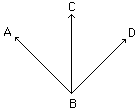|
Mathematics Glossary
- Middle Years
Maxine Stinka, Saskatchewan Education,
Curriculum and Instruction
Note: The
definitions included here are those that are used in the Saskatchewan
Education document "Mathematics 6-9: A Curriculum Guide for the
Middle Level".
Various mathematics dictionaries
may have different definitions. These definitions are designed
to be meaningful to middle level mathematics teachers.
Select the first letter of
the term that you wish to look for.
A | B
| C | D
| E | F
| H | I
| J | K
| L | M
| N | O
| P | Q
| R | S
| T | U
| V | W
| X | Y
| Z
A
abscissa
- the first element in a
coordinate pair. When graphed in the coordinate plane, it
is the distance from the y-axis. Frequently called the x coordinate.
acute angle
- an angle whose measure is between 0o
and 90o.
acute triangle
additive inverses
- two numbers whose sum is 0.
adjacent angles
- two angles that share a vertex
and a common side between them but have no interior points in
common.

< ABC and < CBD are adjacent.
algorithm
- a step-by-step procedure for carrying out
computation.
alternate angles
- two angles that are in opposite locations
when lines are cut by a transversal.
If the angles are between the lines, they are called alternate
interior angles; if they are outside the lines, they are called
alternate exterior angles. If the lines are parallel, the alternate
angles are congruent.
Alternate
interior
c and f
d and e
Alternate
exterior
a and h
b and g
|

|
altitude
- length from the uppermost point of a triangle
to the line opposite.
associative property
- when performing an operation on three or
more numbers, the result is unchanged by the way the numbers are
grouped. Addition and multiplication of numbers are associative
since a+(b+c)=(a+b)+c and (ab)c=a(bc).
i.e. 6 + (7 + 9) = (6 + 7) + 9 and (4 x 3)
x 5 = 4 x (3 x 5).
-
Subtraction and division are not associative.
i.e. (8 / 4) / 2 and 8 / (4 / 2) are not equal.
axis (axes)
- the horizontal and vertical lines that form
the quadrants of the coordinate plane. The horizontal axis is
usually called the x-axis. The vertical axis is usually called
the y-axis.
B
base
of a triangle
benchmarks
- points of reference used in estimation.
e.g. The square corner on a piece of paper
can be used as a benchmark when estimating angle measures.
binomial
- a polynomial
consisting of two terms.
e.g. 3x2 - 8
bisector of an angle
- a segment or ray that divides an angle into
2 congruent
angles.
bisector of a line segment
- a point, segment, ray or line that divides
a line segment into 2 congruent
segments.
box-and-whiskers plot
- a type of graph used in data
management particularly useful in showing the spread of the distribution
of the data.

broken-line graph
- a type of graph used in data
management where the data points are joined by line segments.

Questions or comments about the glossary can
be directed to TheCentralizer@MathCentral.uregina.ca
or see About Us
page for more information.
| 




